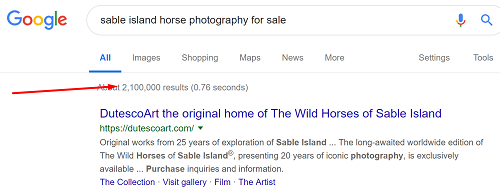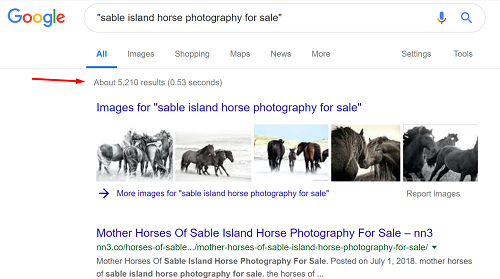Instructions for Optimizing Web Pages for Search Engines (SEO)
1. Keyword Research
Log into Google Keyword Planner
Select appropriated keywords and download list
The next step is to rank the keyword phrases by priority.
Add a column and gave each phrase a ranking of A, B, C, D or X.
A= combination of "sable" "island" "wild" "horses" and "photograph or book or print or poster"
B= missing one of those critera
C= missing more criteria
D= too broad
X= delete, not worth even thinking about
2. Add Number of Competing Pages
Start with the A's.
Don't go any further. We can do the others later.
Copy the keyword phrase
Search on Google.ca
Copy the number of "results"

Now add quotes around the phrase and copy that number to the spreadsheet

You see! This is not a bad keyword phrase to go after.
And notice that the competitors are right at the top.
Ideally, you want to be #1 for this phrase but that is going to take effort, skill, and time.
Add both numbers to the spreadsheet.
3. Select "high-performance keyword phrases"
Now you have to look at the data.
You need to re-prioritize based on the following criteria:
a) Very relevant to what Debra is selling (photographs of wild horses on Sable Island)
b) A low number of competing pages (using the quotes)
c) A high number of searches
d) Will generate sales
4. Group Phrases
Using your list of A priority keyword phrases, sort them into groups of 3.
The phrases should be relevant to each other.
You should have about 5-7 groups (15 to 21 keyword phrases)
5. Align Phrases with Pages
Now try to match each group of phrases to a page on the website
Start on the Home Page and use the best keyword phrases based on the sorting in step #3
6. Optimization Plan
Next plan how you are going to optimize the page
Start with one page and the 3 keyword phrases you have selected for that page
The most important page is the home page. You can start there but realize that we can't change the URL of the home page.
At this stage, you have to write out the exact words that you are going to use for each part of the page that you are going to optimize:
Title
URL
Meta Keywords
Meta Description
Heading
Content
Log into the website page and use your plan to optimize the page
Review those pages with an SEO professional and then make appropriate changes
7. Internal Links
Now find other pages on the website where you can add a link back to the target page.
You are going to add a link on that page with the keyword phrase in the "anchor text" (visible text) and a link back to the target page.
The target page is the page that has been optimized with the keywords and the page that you want to rank high on Google.
But plan first. Send that to me and I'll give you feedback.
It is very possible that you will group 3 phrases together on a specific topic and find out that there is not a page on the website that fits.
This is common and is actually good. This means that you have to create a page that fits the criteria.
But ignore this for now. You can do this later after you have optimized all the pages that you can.